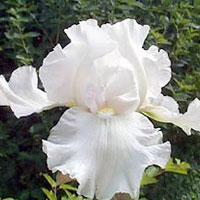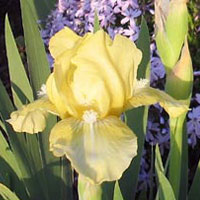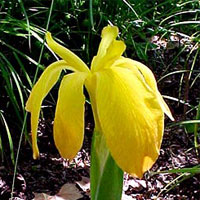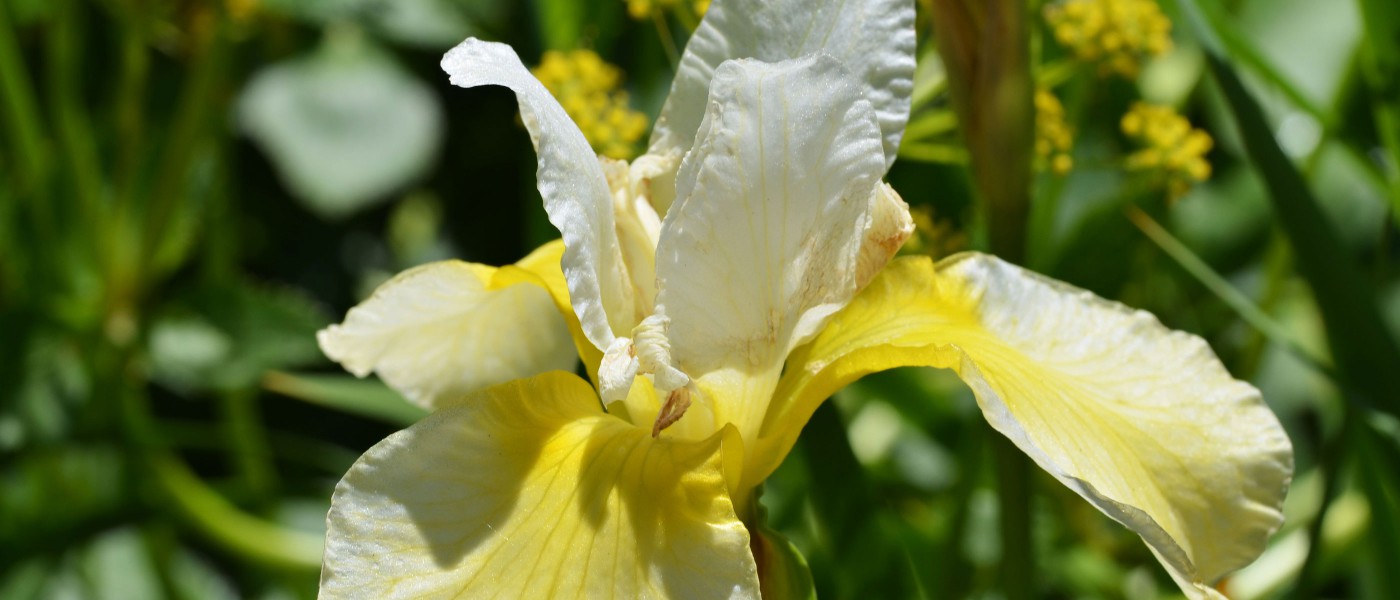Irises for Summer and Fall
"That flower looks just like an iris!" said a friend in disbelief, as she admired my perennial bed in late October a couple of years ago. And indeed, it was Iris 'St. Petersburg', a lovely tall bearded hybrid with violet-tinged white standards and falls, which had bloomed in spring (as most garden irises do) but then bloomed again over summer and fall. Reblooming—or remontant—irises such as this one are becoming increasingly popular as gardeners discover they can dramatically extend the flowering season of one of their favorite plant groups. Iris enthusiasts can also seek out species and cultivars that bloom naturally into the summer.

The iris is a well-known plant in the garden, prized for its linear form and colorful, uniquely structured flowers. But the taxonomy is complex, and it's always good to preface a discussion about irises with a review of the jargon. In brief, iris flowers consist of three upright petals (standards) sitting atop three larger, usually pendent sepals (falls). The Iris genus is large, with over 250 species and many, many cultivars. Horticulturists divide all these into groups and subgroups according to general characteristics such as rootstock type (rhizomatous versus bulbous), place of origin, size, culture, and the presence or absence of colored hairs (beards) in the center of the falls.
The remontant irises are primarily hybrids of plants in the bearded iris group. Breeders have been churning them out like crazy lately: Over the past five years, hundreds of bearded rebloomers in all size categories have been registered with the American Iris Society. Some of these are all-season bloomers, and others bloom in the spring and then only once again in summer or fall. When choosing remontant irises, look for plants that are known to perform well in your part of the country. (Contact your local iris society for recommendations; see "Iris Resources.") That's because along with genetic factors, climate and culture are also important for reliable reblooming.
For gardeners interested in naturally late-blooming irises, choices abound. A number of bearded varieties bloom from early spring to early summer. Among beardless irises, many varieties in the Spuria subgroup bloom from late spring to midsummer. Some Siberian iris (Iris sibirica) and Japanese iris (I. ensata) selections bloom from mid-spring to early summer. Beardless southern blue flags (I. virginica) bloom into early summer. Bulbous irises in the Xiphium subgroup—including Dutch, Spanish, and English irises—flower from mid-spring to midsummer.
Growing Irises
Few perennials bring as much reliable—not to mention brilliant and subtle—color to garden beds and borders as irises do. The remontant and late-blooming cultivars allow us to enjoy this color throughout much of the growing season. As with other garden irises, they range in size from tiny dwarfs to giants over four feet tall. The taller varieties serve well as background plants in perennial borders, while the small ones are perfect for edgings along the front of ornamental beds.

As for site considerations, there are irises to suit just about any soil type, from well-drained (bearded irises) to water-logged (Japanese irises). Xiphium, Pacific Coast, and Siberian irises thrive in soil that is kept moist. The miniature bulbous irises (Iris reticulata and I. danfordiae) require excellent drainage and are thus good candidates for rock gardens. Most irises prefer full sun or light shade and adapt to a wide range of temperature zones.
Following is a selection of some of my favorite remontant and later-flowering iris cultivars. The remontants all rebloom reliably in my garden in Missouri (USDA Zones 5 to 6), usually in late summer or fall, depending on the summer heat. Remontant cultivars are more productive than others, so give them a little extra water and fertilizer, especially after first bloom. Deadheading spent flowers also encourages repeat bloom. Most irises are best planted from midsummer to early autumn, but the plants can be installed in containers whenever the soil is workable.
Iris 'Autumn Tryst'
A remontant tall bearded cultivar, 'Autumn Tryst' grows 2½ to 3 feet tall and has showy, fragrant white flowers with rosy lavender edges. Hardy from Zones 3 to 10, it grows best in full sun and medium-moist soil. The first blooms appear in May. 'Autumn Tryst' is a good choice for mixed perennial beds.
Iris 'Baby Blessed'
This remontant standard bearded dwarf (SDB) is hardy from Zones 3 to 10 and bears yellow flowers on 8- to 15-inch plants, first in the spring and then periodically through the season. Like other SDBs, it can tolerate more shade and a wider range of environmental conditions than other bearded irises. 'Baby Blessed' is a good choice for edges of border beds.
Iris 'Beverly Sills'
Winner of the coveted Dykes Medal, this tall bearded iris grows 2½ to 3 feet tall and produces many flamingo-pink flowers with flaring falls in June. Hardy from Zones 3 to 9, it does best in full sun and medium-moist, well-draining soil. 'Beverly Sills' is very effective when planted in masses.
Iris fulva 'Lois Yellow' (copper iris)
A cultivar of our southern native copper iris, 'Lois Yellow' is hardy from Zones 5 to 9 and grows two to three feet tall. It offers bright green, swordlike foliage and boasts showy yellow flowers from May to June. While best grown in full sun, it will tolerate partial shade, especially in the southern part of its range. The soil should be fertile, slightly acidic, and consistently moist to wet. It is another good choice for water gardens.
Iris 'Golden Harvest'
Growing over two feet tall, this Xiphium iris blooms from late spring to early summer. The graceful single flowers are a rich golden yellow. Hardy from Zones 5 to 8, 'Golden Harvest' needs full sun and well-draining soil. If yellow's not your color, choose a different cultivar. Modern Xiphium cultivars come in white, blue, and purple but otherwise look the same. Excellent in borders and containers, they also make great cut flowers.
Iris 'Rielle'
This border bearded reblooming iris (border bearded irises are in a group known as Medians) is hardy in Zones 3 to 10 and grows 1½ to 2 feet tall. It blooms from May to June, producing intensely white standards overlaid with yellow, and yellow-edged white falls. Grow the plant in full sun and well-draining, medium-moist, humus-rich soil.

Iris 'September Replay'
This tall bearded remontant iris is hardy from Zones 3 to 10 and typically grows three feet tall. The showy flowers feature golden-tan standards and falls, with cinnamon markings on the falls and white borders circling the beards. A good plant for sunny beds and borders, it grows best in full sun and organic, medium-wet, well-draining soil.
Iris siberica 'Butter and Sugar' (Siberian iris)
Hardy from Zones 3 to 8, this Siberian iris grows about 2¼ feet tall. Flowers appear from late spring to early summer sporting white standards and brilliant yellow falls. The plant's thin, arching leaves add an ornamental grass–like texture to mixed borders. 'Butter and Sugar' thrives in full sun to partial shade and medium-to-wet soil.
Iris 'St. Petersburg'
A tall bearded reblooming iris, this cultivar is hardy in Zones 3 to 10 and grows up to three feet tall. Its heavily ruffled standards and falls are brilliant white with a very slight tinge of violet. The falls have greenish-white centers, and the beards are pale lavender. 'St. Petersburg' makes a bright accent in beds and borders of contrasting colors. It's best grown in full sun and fairly organic, well-draining, medium-moist soil.
Iris Resources:
Probably the best source of information on irises is the American Iris Society (AIS). For membership information, call 636-274-6149. The AIS's website (www.irises.org) provides links to local and regional iris societies in the U.S., as well as specialty organizations, such as the Reblooming Iris Society (www.rebloomingiris.com; 903-463-4084). These societies can recommend local growers, but if you are unable to get your irises locally, following are a few mail-order sources.
Ensata Gardens9823 E. Michigan Avenue
Galesburg, MI 49053
269-665-7500
www.ensata.com
Sutton's Iris Gardens
16592 Road 208
Porterville, CA 93257-9011
888-558-5107
www.suttoniris.com


